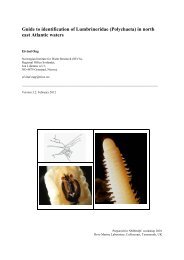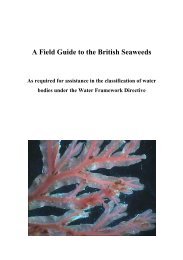You also want an ePaper? Increase the reach of your titles
YUMPU automatically turns print PDFs into web optimized ePapers that Google loves.
The second antenna (antenna) is generally rudimentary in females, with from one to five<br />
articles (Fig. 3A). In males, the shape and length changes at different developmental stages.<br />
In mature males (Fig. 3C), it is well developed with a peduncle of five articles and a manysegmented<br />
flagellum. The outer sides of the fourth and fifth articles of the peduncle are<br />
normally thickly covered with setae. The second antenna is bent backwards between the third<br />
and fourth articles of the peduncle, and the flagellum is closely applied to the sides of the<br />
body. It usually reaches to the end of the body but is sometimes shorter. In some species, the<br />
second antenna is used as an organ for clasping the female. The second antenna is attached to<br />
the upper lip (labrum) (Fig. 3A).<br />
The mouth parts consists the upper lip (labrum), paired mandibles, paired first and second<br />
maxillae and lower lip (labium) (Fig. 3A,D-H). The upper and lower lips are of no taxonomic<br />
significance.<br />
The mandibles (Fig. 3D&E) are simple and always without a palp. Each is normally<br />
boat-shaped, pointed at either end, with a strong molar process and toothed incisor process<br />
and in between them a row of setae and a distal lacinia mobilis (Fig.3D). In some families the<br />
mandibule is reduced to a truncate shape (Fig.3E). In Nannastacidae the mandible is<br />
modified to aid the predatory feeding habit, with a styliform molar process.<br />
The first maxillae (maxillulae) (Fig. 3F) lie ventral to the labium (Fig. 3H) and the second<br />
maxillae (Fig. 3G) ventral to the first pair. Both consist of a flattened protopodite bearing<br />
endites and the first pair have a backwardly directed palp, usually with one or two filaments,<br />
which vibrate in the respiratory chamber and cause a current of water to pass the gills.<br />
In cumaceans, the first three thoracic somites are covered by the carapace but only the first<br />
one is thought to be fused to the head. The first three pairs of thoracic appendages are<br />
maxillipeds and the last five are pereopods. Each has a short coxa fused with the sternite,<br />
followed by the basis, usually the longest article, which may carry an exopodite on its<br />
proximal part, normally with a peduncle and setiferous flagellum but sometimes a rudiment.<br />
Exopods are never present on the first and second maxilliped nor on the fifth pereopods, and<br />
the number on the other appendages varies with the species. In the female oostegites are<br />
borne on the coxae of the third maxilliped and the first three pairs of pereopods, lamellar in<br />
form and interlocking to form the brood chamber. The remaining articles are the ischium,<br />
merus, carpus, propodus and dactyl.<br />
The first maxillipeds are short, robust and highly developed (Fig.3I). The coxa carries a large<br />
epipod (the branchial apparatus). The anterior part of the epipod extends forward and,<br />
together with its counterpart, forms the siphon. Its posterior part forms finger-like branchial<br />
lobules (gills), often more numerous in the male than in the female. Water leaves the<br />
branchial chamber through the siphon.<br />
The second maxillipeds (Fig. 3J) usually have a long basis. The propodus and dactyl are bent<br />
in towards one another and may be modified, with large flattened spines. In the female there<br />
is a flattened plate attached to the hind end of the coxa, the rudimentary oostegite, which has<br />
a fringe of long slender setae directed backwards into the brood chamber.<br />
The third maxillipeds (Fig. 3K) are large, and partly cover the first and second pairs and the<br />
mouthparts. They are sometimes similar in structure to the first pereopods but usually differ<br />
considerably. Long feathered setae are present on the basis, acting as a screen to filter the<br />
9




